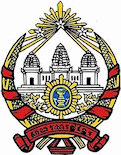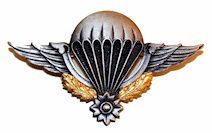Forces Armées Nationales Khmères (FANK)
 The military situation dramatically changed following the coup d’etat in March 1970. Because of its previous deterioration and lack of combat readiness, the newly renamed Forces Armées Nationales Khmères (FANK) of the Khmer Republic encountered serious difficulties as it commenced to undertake operations in the ‘real’ war spreading throughout the nation.
The military situation dramatically changed following the coup d’etat in March 1970. Because of its previous deterioration and lack of combat readiness, the newly renamed Forces Armées Nationales Khmères (FANK) of the Khmer Republic encountered serious difficulties as it commenced to undertake operations in the ‘real’ war spreading throughout the nation.
On 18 March 1970, at the time of Prince Sihanouk's ouster and the establishment of the Republican government, the Khmer Armed Forces (FANK) consisted of approximately 35,000 men. This included a 32,000 man Army, with 32 battalions, armed with mixed weapons; a 1,600 man Navy, with 11 boats; and a 1,300 man Air Force, with 15 aircraft.
Beginning with less than 35,000, the FANK was forced to conduct a risky military conscription program under the banner of ‘general military service’. The survival of the Khmer Republic (GKR) during its first year of existance was to a great extent the result of emergency recruitment and massive rallying to a popular cause. US equipment provided for newly formed units consisted of Soviet AK-47 rifJ.es captured in RVN and cast off US cal 30 carbines.
In response to a declared state of emergency, and the requirement to expand the force to 210,000 as demanded by the leaders of the Khmer Republic, the size of the force became dramatically inflated, bypassing most training procedures. Many infantry units literally sprang into existance during this time frame. Individually recruited by local commanders, themselves newly appointed, the units lacked both training and equipment. Uncontrolled strength increases occurred, reaching their zenith in December 1972, when FANK consisted of approximately 561 battalions subtended under a diverse array of "command" headquarters.
Units were not standardized in either organization, strength, equipment or training. Uncontrolled personnel strength reporting and the "phantom" problem were an inevitable outgrowth of such turmoil. The armed forces were eventually comprised of a mixture of students, civil servants and villagers who had received very little or no basic military training. However, some combatant and specialist units, and a number of military personnel, did receive overseas training with the support of the US, South Vietnam, Thailand, Laos, Indonesia, the Philippines etc.
 In 1971 and 1972, the United States provided the local currency equivalent of about $56 million to support military pay and allowances. These funds were commingled with Cambodian Government resources and could not be attributed to payments to specific troops or units. However, the availability of such large amounts undoubtedly facilitated corrupt pay practices. GAO investigated allegations that Cambodian Army unit commanders inflate their payrolls and pocket the pay of nonexistent (phantom) troops. American officials acknowledged that corrupt payroll practices had existed for some time and that, despite corrective efforts, the problem of phantom troops had not been eliminated. However, neither the American officials nor the Cambodian Government knew the extent of the corrupt practices. Using estimated percentages of padded troop strengths provided by U.S. officials in Cambodia GAO estimated that Cambodian military commanders may have drawn the local currency equivalent of $750,000 to $1.1 million in January 1973 for phantom-troop pay.
In 1971 and 1972, the United States provided the local currency equivalent of about $56 million to support military pay and allowances. These funds were commingled with Cambodian Government resources and could not be attributed to payments to specific troops or units. However, the availability of such large amounts undoubtedly facilitated corrupt pay practices. GAO investigated allegations that Cambodian Army unit commanders inflate their payrolls and pocket the pay of nonexistent (phantom) troops. American officials acknowledged that corrupt payroll practices had existed for some time and that, despite corrective efforts, the problem of phantom troops had not been eliminated. However, neither the American officials nor the Cambodian Government knew the extent of the corrupt practices. Using estimated percentages of padded troop strengths provided by U.S. officials in Cambodia GAO estimated that Cambodian military commanders may have drawn the local currency equivalent of $750,000 to $1.1 million in January 1973 for phantom-troop pay.
In part, the increased effort to raise the combatant capability of the FANK stemmed from the bombing by US aircraft. From March 1969 to August 1973 the US dropped 539,129 tons of bombs on Cambodian soil, with just under half of this tonnage, approximately 257,465 tons, being dropped during the period 24 February to 14 August 1973. The bombing not only took the lives of thousands of Khmer people, but it also pushed the Viet Cong movement deeper into Cambodia’s territory. One of the bitter tragedies of this bombing campaign occurred on 7 August 1973 when a flight of US B52s dropped approximately 20 tons of bombs on the crowded public markets and hospital of Neak Loeung; killing 137 and wounding 298 people, mostly combatants and their families.
During 1972 and the first half of 1973, the emphasis was on the training and equipping of standardized infantry battalions, and the reorganization of the FANK force structure into four divisions comprising 12 brigades, 20 independent brigades, 74 separate territorial infantry battalions, and 465 territorial infantry companies. In early 1973, the emphasis was on accelerating the delivery of artillery and the introduction of armored cavalry troops into the force structure. Finally, in the latter part of 1973, increased emphasis was given to bringing in equipment for logistical units in order to maintain the large influx of equipment that had occurred in the past two years. Increased and/or unprogrammed ammunition costs necessitated signiricant slippage in the rounding out of this logistical portion of the force structure.
The state of FANK's material readiness by late 1973 was somewhat better than the manpower situation, especially following the acceleration of Military Aid Program (MAP) deliveries prior to the 15 August cessation of US air operations, but there was cause for concern. Continued resupply through the US MAP was vital to the maintenance of adequate supplies for FANK. Levels of MAP support were in accord with FANK's ability to absorb new equipment, and most of FANK's hardware deficiencies had been alleviated.
On the other hand, present levels of support may not be adequate to maintain ammunition stocks during another period of sustained combat since a substantial portion of the FY 1974 appropriation was consumed during the 1973 offensive. Any reduction in MAP funding would similarly deplete ammunition stocks, although it probably would not have a signifi cant impact on the availability of hardware.
Two additional factors made FANK's supply status tenuous. The first was the government's reliance on three key entry routes - the Mekong, Pochentong Airport, and Highway 4 from the Port of Kompong Som - for MAP deliveries. Given the vulnerability of these lines of communication, it would be difficult for FANK to maintain stocks on hand. Second, FANK's internal distribution system, although greatly improved in the three years from 1970 through 1973, and facilitated by equipment standardization, remained undependable. More over, because of FANK's reliance on over land routes and only a limited aerial resupply capability, the system remained subject to interdiction. A significant result of this was the reluctance of FANK artillery commanders to fire harassment and interdiction missions. against the KC for fear that their ammunition stocks will not be replenished if a more immediate need arose.
Uncertainty of resupply aside, artillery supply for FANK units still remained limited. Although FANK was reasonably well equipped with artillery (the ratio of tubes to ground forces strength compared favorably with ARVN), most of the tubes were deployed in static defensive positions, thus restricting their use for offensive operations. Moreover, despite an extensive training program - both internal and external - the level of expertise varied greatly, and generally remained low. Operations were generally hampered by the limited number of fire direction, ammunition handling and forward observation personnel.
The end of 1973 thus saw the Army force structure 80% complete, with the primary deficiency being in some programmed but undelivered logistical units. FANK ground combat strength was estimated to be about 110,000-130,000 (out of a total military strength of almost 210,000) organized in company to division sized maneuver units. Combat units had a dual role - mobile operations against the Communists and static defense - and were primarily deployed around major towns and cities and along lines of communication. Limited support was also drawn from a nascent Auto-Defense (militia) program which bolstered local defense in conjunction with FANK. Although Auto-Defense strength was about 60,000, the generally poor state of readiness of these units restricted their combat capabilities.
FANK's inability to exploit its roughly 2 to 1 numerical superiority stemmed from a number of factors. The most critical of these was the continuing lack of effective leadership. FANK entered the war with few capable leaders, and only a handful had emerged since that time, especially at the middle and upper levels. Commanders in the field continued to adhere to a garrison mentality stressing fixed defensive positions, frequently abandon positions in the face of little or no pressure, and often drag their feet when ordered to initiate operations against the Communists. Through a combination of a lack of aggressiveness and frequent absenteeism from their units in the field, most commanders fail to instill the motivation and discipline in their troops necessary to accomplish even a successful defense.
A major factor affecting FANK morale was the overall impact of low pay and inflation on the individual soldier's ability to provide for his family. In spite of some efforts to ameliorate the situation, basic sustenance and shelter remained beyond the means of most, and only substantial reform in this area by the Phnom Penh Government could halt the present downward trend.
Accentuating the problem of ineffectual leadership in the field is the quality of support provided by FANK's staff. Operations were hampered by constantly changing and conflicting mission orders, and very little initiative has been shown in anticipating Communist pressures - the staff preferring instead to commit units piecemeal only after the situation has deteriorated. The retrieval of the situation at Kompong Cham in September 1973 was the first time that the General Staff acted decisively to define objectives and deploy the necessary forces.
Closely akin to the problem of unit rosters padded by "phantom" troops was the absence, until 1973, of a rational system of personnel replacement. It was not until mid-summer 1973 that conscription was attempted, and the initial attempts proved ineffective. With recruitment largely in the hands of local commanders, many FANK units - particularly among the reaction forces of the General Reserve - had been badly worn down by months of fighting, to the point that FANK's four divisions (the backbone of the General Reserve) could field only about half of their authorized strength at the height of the Communist 1973 summer offensive. Moreover, approximately one-third of FANK's troops remained untrained. The internal training burden had been substantially increased since the termination of the extensive US/South Viet namese training program in South Vietnam.
The effectiveness of FANK leadership was further restricted by a degree of corruption which, at times, was excessive even by the accepted standards of the area. One manifestation of this "payroll padding" had a critical impact on FANK operations because units committed to combat frequently had been found to be substantially below reported strength, and thus only marginally effective.
Full dependence on the US, and unrecoverable corruption and the deadlock in political solutions resulted in the Khmer Republic facing a heavy social crisis. Approximately 2 million refugees poured into the cities, resulting in malnutrition, chaos and inflation. Serious corruption in the military encouraged ghost, irregular and unpaid soldiers with low morale, which resulted in the regime collapsing hastily.
|
NEWSLETTER
|
| Join the GlobalSecurity.org mailing list |
|
|
|

